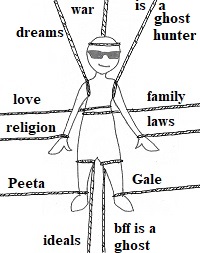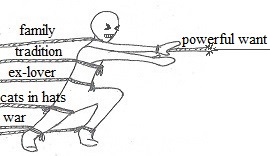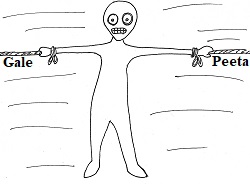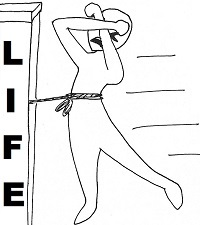Tied Up in Strings: How Internal Tension Moves Your Character
 Imagine for a moment everything your character cares about—Love, Friendship, Family, Country, Ideals, Religion, Tradition, Self, and Things More Specific—as a string, wrapped around your character.
Imagine for a moment everything your character cares about—Love, Friendship, Family, Country, Ideals, Religion, Tradition, Self, and Things More Specific—as a string, wrapped around your character.
The more your character cares about that thing, the tighter that string is pulled—the more tension on the line.
The more strings? The more interesting it gets.
Tension to Trajectory
 Now, if there’s only one string around your character’s body, then when that string is pulled, your character will move in that direction, reducing the tension. In this way, tension becomes trajectory.
Now, if there’s only one string around your character’s body, then when that string is pulled, your character will move in that direction, reducing the tension. In this way, tension becomes trajectory.
Chances are, your character doesn’t just have one string around their body. They have many, and most of the time, those strings are in balance. But when one thread is pulled hard? Your character still wants to move in that direction, to  reduce the tension. But they can’t, because there are all these other damn threads wrapped around them, pulling them back.
reduce the tension. But they can’t, because there are all these other damn threads wrapped around them, pulling them back.
Take Romeo & Juliet. Their tightest threads are Love and Family—threads that pull the characters in opposite directions. And the tug of war between those threads—Love being drawn tighter and tighter, Family straining and thinning to near-breaking—is fucking magnetic. As it is almost any time one thread is pulled so  tight that it compromises another, putting the whole system out of balance—be it Romeo & Juliet’s Love over Family, Thelma and Louise’s Friendship over Lawfulness, or Hamilton’s Idealism over Love.
tight that it compromises another, putting the whole system out of balance—be it Romeo & Juliet’s Love over Family, Thelma and Louise’s Friendship over Lawfulness, or Hamilton’s Idealism over Love.
Forward Tension vs. Sideways Tension
Strings that pull in opposing directions have the most direct tension, but strings around your character don’t just pull in two directions. They pull every direction.
 Strings that pull in balanced opposition to one another provide sideways tension. They tear your character apart inside—one pulling on the left arm, the other on the right—but like a love triangle, they don’t provide a clear path forward. Your character doesn’t know which way to move, and so they don’t drive the action.
Strings that pull in balanced opposition to one another provide sideways tension. They tear your character apart inside—one pulling on the left arm, the other on the right—but like a love triangle, they don’t provide a clear path forward. Your character doesn’t know which way to move, and so they don’t drive the action.
When one string has a strong pull, and it has either no opposing string or an opposing string with a weaker pull, then your character has forward tension. Given no internal sources of opposition, your character feels a strong drive to DO THE THING the string requires of them.
Internal Tension vs. External Forces
Of course, even if there’s no opposing string to your character’s desire, that just means there’s  no internal tension stopping your character from pursuing their goals. The outside world might have different ideas! External forces are often the main opposition to characters with strong forward tension. This means the character might want something really badly, but the world is acting to counter it. External forces can also create consequences that shape some of the strings of sideways tension.
no internal tension stopping your character from pursuing their goals. The outside world might have different ideas! External forces are often the main opposition to characters with strong forward tension. This means the character might want something really badly, but the world is acting to counter it. External forces can also create consequences that shape some of the strings of sideways tension.
The important thing to realize is that even though they play a similar role, external forces do not replace internal tension. You can have all the external forces in the world, but if your character doesn’t have their own internal tension driving them forward, it will be like dragging them through molasses. Instead, it plays a complimentary role. Characters have a strong goal pulling them forward, and external forces make them have to work harder.
Tension Shapes Your Story
Most stories have both kinds of tension! Stories with forward tension than sideways tension tend to be more plot-driven stories. Not in that they don’t have fantastic characters, but in that the plot is the primary source of tension, and if you take out the plot, they fall apart. Like The Hunger Games.
Stories with more sideways tension than forward tension tend to be more character-focused. They usually have a plot! But the characters are the primary source of the tension, and if you took one of them out, the story falls apart. Like Romeo & Juliet.
(Erin M. Evans turned me on to this fascinating article by Kristen Kieffer on how to choose the perfect title for your story based on whether your book is plot- or character-driven—give it a read for more insight.)
How to Use This Weird Metaphor
All right, so great! You’ve tied up all your characters. Now what?
I think most useful application is troubleshooting spots in your story where the tension drops or feels off. Ever gotten to the end of a chapter and felt the momentum just drop, despite a strong feeling of tension? Maybe that tension is sideways tension! Check to see if you need an extra beat to pull your characters’ forward tension into things. Or maybe you’ve felt like the momentum is steering your characters to the point where they don’t have room to make mistakes or grow as characters. Then you might want to look at your sideways tension!
But it can also be useful at the idea or outlining stage, when you’re trying to figure out what kind of story it is exactly, and where you might need to shore it up.
And you can also use it to analyze why certain characters and stories grab you so well—what about the structure of their tension works for you. And then steal that precious magic for yourself!
Or you could just tie up your characters for the fun of it. I mean, you do you.
YMMV
Of course, this all these strings and tension things are just a tool! (And an extended metaphor I had waaay too much fun with.) If they help you, that’s awesome! That was the intent. If they don’t—sorry, disappointed internet stranger! I hope you find the tools that help you on your next Google.
Happy Writing!
